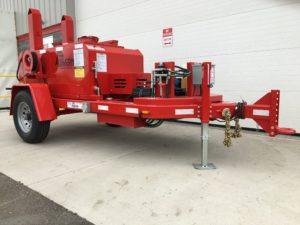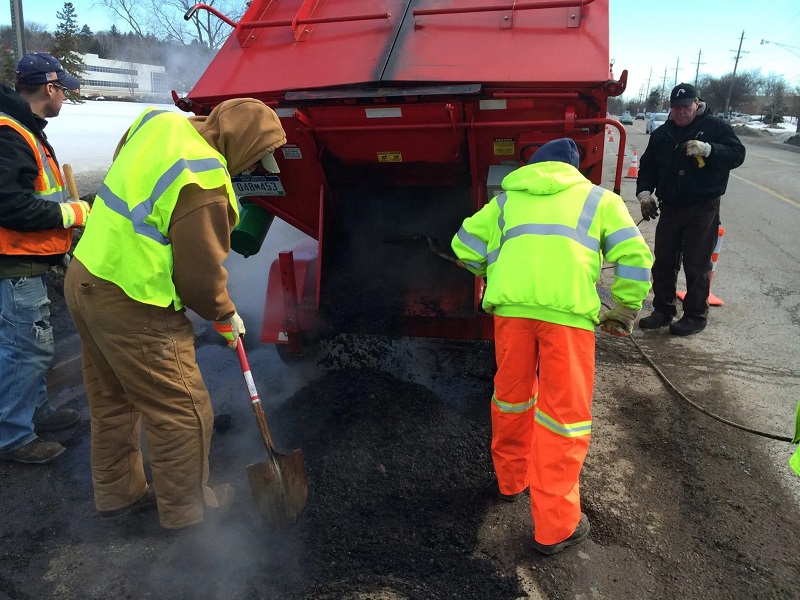However, there are ways to significantly reduce multiple operating costs and ensure that the repair jobs last for several years—instead of just a season or two. Read on to learn more about the three main pothole repair work costs and the best practices that can help significantly reduce them.
Materials
Many asphalt patching operations will utilize cold mix to perform repairs since it’s less expensive than hot mix asphalt. This can result in immediate material savings, however, the cost-benefit is only temporary. With an average lifespan of one year, cold mix is nowhere near as good nor lasts as long as the 1-3 year lifespan of hot mix asphalt.
A downside to hot mix asphalt is that you can only use it when the outside temperature is 40F degrees or higher. This means that some emergency repairs will still require cold mix during the cooler months of the year. When the spring thaw comes around, the cold mix patch can be replaced with a more permanent hot mix one.
Labor
The labor cost is directly tied to the size of the patching crew. For example, smaller public works departments can get away with using a single laborer who utilizes the throw-and-go technique. A much larger municipality will opt for the throw-and-roll method that requires one worker to drive the truck and the other to add the asphalt to the pothole.
For semi-permanent repairs, four workers are often the most ideal for productivity and efficiency. Using this method, two of them will prepare the pothole by cleaning and squaring the edges while the other two will follow behind and perform the repairs.
While this method is more costly than other ones, it can save tremendous time and money by preventing the same pothole from reemerging every year.
Traffic control is another labor cost. Whether it’s a safety truck slowly following the spray-injection equipment or one or more workers whose job is manually directing traffic around the repair operations, these jobs can pose a safety risk to workers.
A single accident can cost hundreds of thousands or even millions of dollars in terms of medical expenses, insurance, and equipment damage.
Equipment
The cost of equipment will vary depending on the type of repair method used. For example, throw-and-go or throw-and-roll only require rakes, shovels, and miscellaneous hand tools.
If using the semi-permanent method, workers will need a jackhammer, an air compressor, a compactor, and saws. Spray injection operations require a trailer-mounted or self-contained spray injection device.
How to Reduce Costs

There are several ways municipalities and repair operations can reduce pothole repair costs:
Using Better Materials—Even if they’re more costly upfront, using better materials will save tremendous amounts of money in the long run.
Cold asphalt is nowhere near as strong as hot mix asphalt and is only ideal for temporary fixes until it’s possible to implement a more permanent repair solution.
Hot mix asphalt is weather resistant, quick to cool down, strong, and will bend but not break. This makes it the ideal material for pothole repairs that will last several years.
Using Better Equipment—Instead of a traditional dump truck, consider investing in an asphalt hot box and recycler, which can help save time and money. The ergonomic design of the hotbox means that your workers won’t be shoveling mixture at awkward angles, which can cause a slowdown in productivity and even injury.
A Falcon Hot Box and Recycler can also hold hot mix overnight and for up to 72 hours. This will save your crews from making multiple trips back and forth to the asphalt plant and will allow them to recycle asphalt chunks and millings out in the field.
Utilize Proactive Measures—It’s important to identify proactive pavement preservation techniques that will help prevent potholes from forming over time. For example, the Minnesota Department of Transportation released a study that details several asphalt preservation activities, such as:
- Crack filling
- Route and seal cracks
- Micro-surfacing
- Ultra Thin Bonded Wear Course (UTBWC)
- Thin Overlay or Thin Lift Mill and Overlay 1” to 1.5″
- Thin Overlay or Thin Lift Mill and Overlay 1.5″
- Ultra Thin Bonded Wear Course (UTBWC)
- Seal coat
Reduce Operation Costs With a Falcon HotBox
Falcon hotboxes will help reduce pothole repair costs while increasing production rates. We offer a wide range of customization options to meet the exact needs of your asphalt patching operations. Contact us today or click below to learn more about our equipment.


Recent Comments